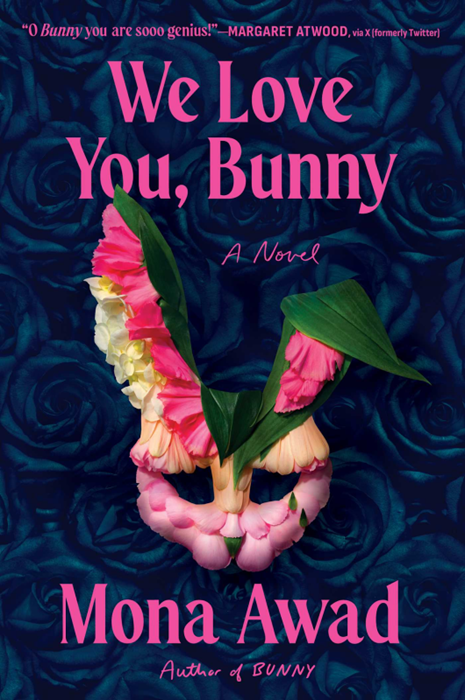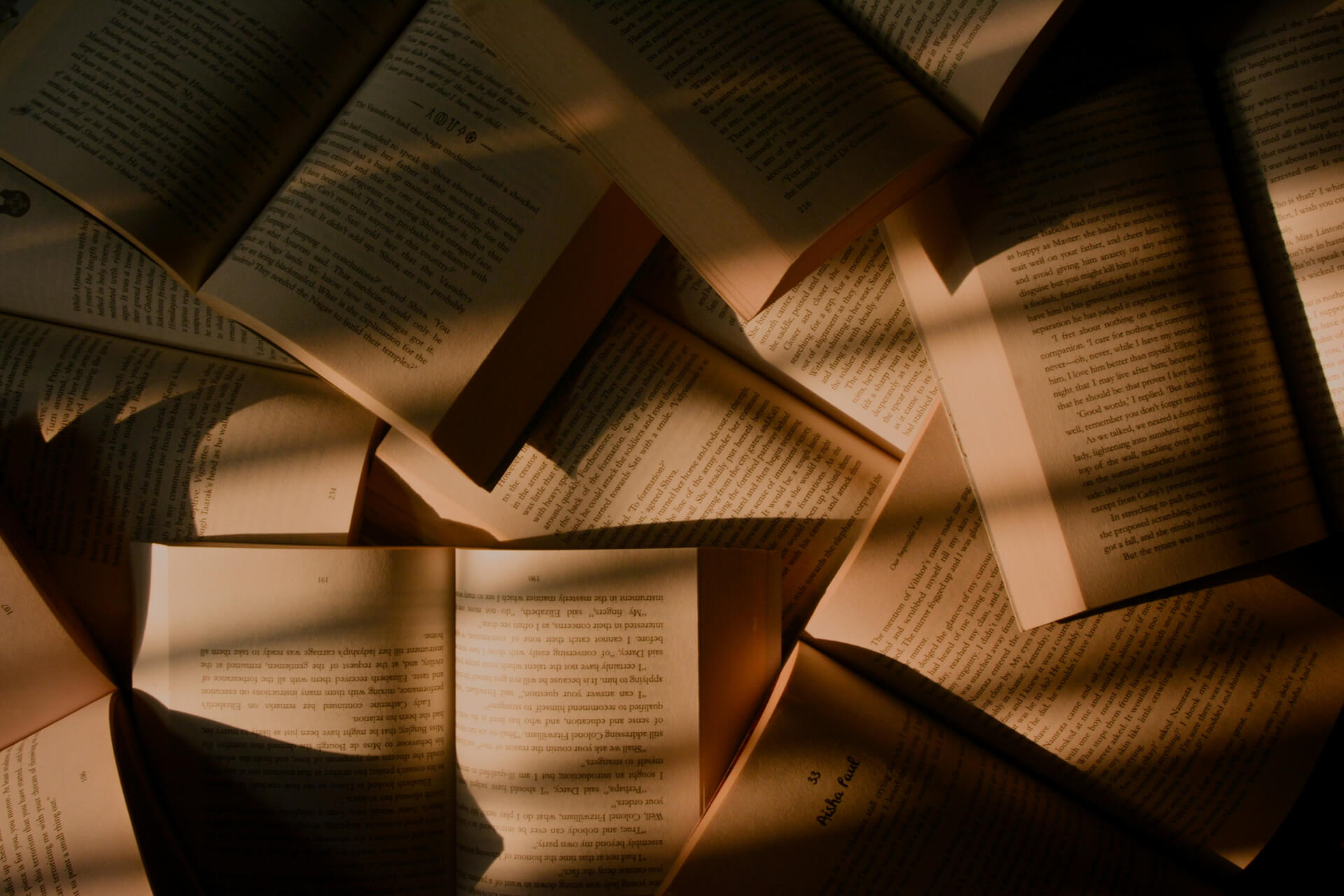“But back then, as you know, we were such innocents, Bunny. Really just trying to make something beautiful in the night, you know?”
As with her other releases, Awad specialises in ambiguity, unreliable narrators, and the horrors of human (especially female) experiences. This certainly was true of her new release, We Love You, Bunny.
Synopsis
In this story, it is revealed that Bunny is the book published by Samantha, the protagonist. After its release, the Bunnies are far from pleased with their depictions, so they kidnap her and recount their experiences. The narrative follows five main monologues: the Bunnies (Coraline, Kyra, Viktoria, and Elsinore) — as well as the Bunny they create, Aerius. It provides context for some of the background events from Awad’s previous book, while also tangling us even deeper into the web that is the Monaverse.
It’s About Creation, Bunny
The main theme of the book is creation. Set on Warren University Narrative Arts campus, a lot of the themes revolve around writing. As someone who studied creative writing at university, this felt quite relatable (aside from the ambiguity and axe murders, of course), as sometimes there were pretentious and competitive students. This dynamic is portrayed across all of the Bunnies’ monologues, where each believes herself to be the best. This was particularly emphasised through their tone and in the use of capitalising verbs that they believe to be important, which is further exaggerated by Aerius adopting this same habit in his monologue as the amalgamation of the Bunnies.
Mona alludes to rabbits as metaphors for muses, and alternatively the inspirations behind creativity. She portrays this when Coraline receives critique in a writing workshop:
“I didn’t hear the words exactly, I felt them. Like daggers to my wrists. […] Allan went on about why exactly I was terrible and my story was terrible. He took a copy out of my piece covered in […] stab wounds. […] this man drawing lines through my carefully chosen adjectives, probably with an erection. […] Thinking he knew so much. About craft. About narrative.”
This dejected passage shatters her illusion that her writing is masterful, that they have “innate talent”, and creates a common enemy for the Bunnies.
After this, the Bunnies, fuelled by hatred and passion, create Aerius from a bunny they see in the garden. As Aerius is a creation from the Bunnies’ collective psyche, their hatred of Professor Allan manifests in violent behaviour towards anyone called Allan. When the Bunnies are worried by his violent nature, they lock him in Kyra’s loft, where Awad portrays the idea of writer’s block. Awad also shows that the Bunnies feed off the compliments and flattery of Aerius to feel inspired and create new work. They use him to “Tap into the Wound,” infusing writing with pain drawn from personal experience.
Ouch, It’s Writer’s Block, Bunny
One day, the Bunnies discover that Aerius has escaped. This moment represents Awad’s allusion to them facing writer’s block, as their source of inspiration has left them. This is also where the first axe murder occurs: an act of mistaken identity, in which Aerius believes he has killed Allan, only to realise it was just someone quoting Edgar Allan Poe. He flees again and encounters the Poets, leaving the Bunnies without their “Muse.” Without Aerius, they cannot create, a shortcoming both professors critique — which Awad demonstrates here:
“Of course, it wasn’t our lack of innate talent–how could it be, given our amply demonstrated genius? No, circumstances were blocking our Potential, […] Our ongoing heartbreak. […] Not to mention the sheer fucking teacherly neglect–first Allan’s and now Ursula’s.”
After another axe murder, Aerius leaves and is later found by Ursula. Before his arrival, Ursula is described as being “in the creative Shadows. […] Waiting for the still, small Murmur of the Source to whisper in her Ear.” This marks the third time in the narrative that Aerius has been locked away and forced to create. I believe this reflects Awad’s argument that she wants the writing industry to return to a state where creation is authentic — not inauthentic, mass-produced, and soulless pieces of fiction.
Rewriting, Criticisms, and Destruction, Bunny
As this book serves as a retelling of the first Bunny, it gives Awad the opportunity to reflect on her journey since writing it — offering both commentary and a reimagining of the same story from different perspectives. Many low-rated reviews of Bunny claimed it was “too weird” or “ambiguous,” suggesting that some readers never tried to uncover its deeper meaning. As I mentioned earlier, to me, Bunny has always been about writing and We Love You, Bunny makes that even clearer.
Beyond writing itself, the novel also explores the inauthentic and pretentious creatives who struggle to shape art into something meaningful. This could be what the humanised bunnies and their bunnies rituals represent: falsified and performative art. On the other hand, the romanticisation of using upsetting personal experiences as “content” is equally troubling. Awad captures this through Ursula’s husband speaking to Aerius:
“Still tapping away at your Wound? […] I hope it bleeds for you. I hope it veritably gushes forth. What the World absolutely needs is another Wound. Another bleeding Writer sharing their hard-earned Truths.”
As well as this, the book also explores the destructive, arrogant, and superior nature of some critics. Perspectives like these are damaging, as they shun experimentation unless it aligns with the styles they personally gravitate toward, often speaking in elaborate code to further alienate those who don’t fit in. Awad illustrates this through Allan and Ursula’s vague and unhelpful workshop feedback, with remarks like: “the authorial musicality prevaricates” (What does that even MEAN?) and “Let the Source speak.”
This unclear advice not only infuriates the Bunnies but worsens their writer’s block, leaving them with no real guidance to improve their art. This writer’s block is amplified by the line: “We always seemed to be watching something escape us that spring,” paralleling their writing experience with Aerius’s disappearance.
Overall
I did enjoy being back in this world, as it was nostalgic, but I’m not sure how necessary it was within Awad’s universe. I absolutely love everything she releases and will continue to read anything she writes, but this one felt like a slightly random addition. Personally, I prefer when her books explore something entirely new.
That said, I liked getting new perspectives and seeing what was happening in Samantha’s background, but it didn’t feel like something I needed. Bunny had a very open-ending, yes, but it felt intentional, as if the story had already concluded.
Moreover, Aerius’s speech, a mix of the Bunnies’ voice, pretentious phrasing, obscure references, poor spelling, and (in my opinion) an egregious amount of emojis — lowered what I hoped to be a five-star read. Still, a four-star rating is high for me, and I would still recommend this to readers, especially if you loved the original. I can’t wait to see what Awad writes next!
Have you read this book?
We would love to hear your thoughts on this book, perhaps you agree with our review, or, disagree?





